Hierarchical Hypervapotron Structure Integrated with Microchannels for Advancement of Thermohydraulic Performance
Abstract
:1. Introduction
2. Experimental Setup and Data Reduction
2.1. Specification of Experimental Flow Loop
2.2. Introduction of Test Section
2.3. Experimental Procedures
2.4. Data Reduction
3. Experimental Results and Discussion
3.1. Wall Temperatures
3.2. Heat Transfer Coefficient
3.3. Pressure Drop and Flow Instability
3.4. Comprehensive Performance
4. Conclusions
- The average bottom wall temperatures of the LMHC and TMHC were generally lower than FHC at the same effective heat flux in all conditions, TMHC obtained the lowest wall temperatures, and the temperatures of the LMHC were insensible to the flow velocities;
- The heat transfer coefficients of the LMHC and TMHC were greater than those of the FHC due to the expanded heat transfer area provided by the integrated microchannels; the TMHC yielded the greatest heat transfer coefficient (maximumly increased by 132%, 120%, and 117% at a liquid velocity of 0.65, 0.97, and 1.3 m/s compared to FHC) because the transverse arranged microchannels promoted the convection and liquid replenishment capability by introducing branch flow between fins. The heat transfer coefficients of the LMHC were insensible to the flow velocities due to the block effect of the longitudinal microchannels;
- The LMHC obtained the largest pressure drop on account of the increased frictional pressure loss caused by the block effect; the pressure drop for the FHC and TMHC were comparable at low-to-medium heat flux since the effect of the transverse microchannels on the frictional pressure loss was minimal. However, the pressure drop for the TMHC exhibited a sharp increase at high heat flux (qeff > 13.8 MW/m2) which indicated that the full development of flow boiling dramatically enlarged the vapor acceleration pressure loss;
- The TMHC generally obtained the highest Figures of Merit (FOM) with the FHC set as the baseline, which indicated the significant thermohydraulic performance of the TMHC and might bring critical insight to the structural design of hypervapotron devices.
Author Contributions
Funding
Data Availability Statement
Conflicts of Interest
References
- Artsimovich, L. The Road to Controlled Nuclear Fusion. Nature 1972, 239, 18–22. [Google Scholar] [CrossRef]
- Sadik-Zada, E.R.; Gatto, A.; Weißnicht, Y. Back to the future: Revisiting the perspectives on nuclear fusion and juxtaposition to existing energy sources. Energy 2024, 290, 129150. [Google Scholar] [CrossRef]
- Motojima, O. The ITER project construction status. Nucl. Fusion 2015, 55, 104023. [Google Scholar] [CrossRef]
- Qin, S.; Zhao, S.; Cao, J.; Wang, Q.; Feng, X.; Chen, S. Reliability research of hypervapotron under electromagnetic load for CFETR divertor. Fusion Eng. Des. 2024, 202, 114422. [Google Scholar] [CrossRef]
- Peng, X.; Ye, M.; Song, Y.; Mao, X.; Chen, P.; Qian, X. Engineering conceptual design of CFETR divertor. Fusion Eng. Des. 2015, 98–99, 1380–1383. [Google Scholar] [CrossRef]
- Li, M.; You, J.-H. Interpretation of the deep cracking phenomenon of tungsten monoblock targets observed in high-heat-flux fatigue tests at 20 MW/m2. Fusion Eng. Des. 2015, 101, 1–8. [Google Scholar] [CrossRef]
- Zhao, B.; Musa, S.; Abdel-Khalik, S.; Yoda, M. Experimental and numerical studies of helium-cooled modular divertors with multiple jets. Fusion Eng. Des. 2018, 136, 67–71. [Google Scholar] [CrossRef]
- Rindt, P.; van den Eijnden, J.L.; Morgan, T.W.; Lopes Cardozo, N.J. Conceptual design of a liquid-metal divertor for the European DEMO. Fusion Eng. Des. 2021, 173, 112812. [Google Scholar] [CrossRef]
- Li, Q.; Zhao, S.X.; Sun, Z.X.; Xu, Y.; Li, B.; Wei, R.; Wang, W.J.; Qin, S.G.; Shi, Y.L.; Xie, C.Y.; et al. Development and application of W/Cu flat-type plasma facing components at ASIPP. Phys. Scr. 2017, T170, 014020. [Google Scholar] [CrossRef]
- Chen, X.; Qin, S.; Wang, Q.; Cao, J. Fatigue life prediction of hypervapotron for CFETR divertor. Fusion Eng. Des. 2022, 174, 112985. [Google Scholar] [CrossRef]
- Zhu, G.; Bi, Q.; Yan, J.; Wang, T.; Zhao, J. Heat transfer characteristics of subcooled water in a hypervapotron under high mass fluxes and high heat fluxes. Int. J. Heat Mass Transf. 2019, 129, 580–590. [Google Scholar] [CrossRef]
- Escourbiac, F.; Schlosser, J.; Merola, M.; Bobin Vastra, I. Experimental optimisation of a hypervapotron® concept for ITER plasma facing components. Fusion Eng. Des. 2003, 66–68, 301–304. [Google Scholar] [CrossRef]
- Youchison, D.L.; Ulrickson, M.A.; Bullock, J.H. Effects of Hypervapotron Geometry on Thermalhydraulic Performance. IEEE Trans. Plasma Sci. 2012, 40, 653–658. [Google Scholar] [CrossRef]
- Zhao, Y.; Zhang, M.; Hou, F.; Gao, T.; Chen, P. An experimental study of hypervapotron structure in external reactor vessel cooling. Nucl. Eng. Des. 2016, 303, 42–49. [Google Scholar] [CrossRef]
- Wu, Z.; Qian, X.; Peng, X.; Song, Y.; Song, W.; Song, F.; Liu, P. Modeling of subcooled flow boiling for hypervapotron in divertor of fusion reactor based on RPI model. Case Stud. Therm. Eng. 2023, 49, 103289. [Google Scholar] [CrossRef]
- Feng, S.; Peng, X.; Song, Y.; Liu, P.; Song, W.; Mao, X.; Qian, X.; Salman Khan, M. Development of continuous V-shaped structure for high heat flux components of flat-type divertor. Nucl. Mater. Energy 2023, 35, 101419. [Google Scholar] [CrossRef]
- Qi, L.; Shifeng, M.; Zhongwei, W.; Xufeng, L.; Minyou, Y. Study on the effect of fin structure on heat transfer performance of hypervapotron structure. Nucl. Fusion Plasma Phys. 2019, 39, 48–54. [Google Scholar] [CrossRef]
- Cao, J.; Qin, S.; Wang, Q.; Chen, X.; Feng, X. Reliability research of hypervapotron under steady-state thermal load. Fusion Eng. Des. 2022, 180, 113191. [Google Scholar] [CrossRef]
- Ezato, K.; Suzuki, S.; Sato, K.; Taniguchi, M.; Hanada, M.; Araki, M.; Akiba, M. Critical heat flux test on saw-toothed fin duct under one-sided heating conditions. Fusion Eng. Des. 2001, 56–57, 291–295. [Google Scholar] [CrossRef]
- Lim, J.H.; Park, M. Effect of Hypervapotron Fin Angle on Subcooled Flow Boiling Heat Transfer Performance Under One-Side High-Heat Load Condition. Fusion Sci. Technol. 2022, 78, 395–413. [Google Scholar] [CrossRef]
- Chen, Z.; Li, Q.; Peng, W.; Wei, R.; Wang, W.; Jiang, K.; Wang, J.; Pan, Z.; Xie, C.; Geng, X.; et al. Study of W/Cu flat-type mock-ups with novel hypervapotron cooling structure for CFETR divertor. Fusion Eng. Des. 2021, 172, 112919. [Google Scholar] [CrossRef]
- Chen, Z.; Li, Q.; Zhou, Z.; Wang, X.; Zhao, B.; Peng, W.; Du, F.; Wang, W.; Yang, Z.; Xu, Y.; et al. Experimental investigation on heat transfer characteristics of a novel hypervapotron channel for divertor target in nuclear fusion reactors. Nucl. Mater. Energy 2024, 39, 101651. [Google Scholar] [CrossRef]
- Erp, R.; Soleimanzadeh, R.; Nela, L.; Kampitsis, G.; Matioli, E. Co-designing electronics with microfluidics for more sustainable cooling. Nature 2020, 585, 211–216. [Google Scholar] [CrossRef]
- He, Z.; Yan, Y.; Zhang, Z. Thermal management and temperature uniformity enhancement of electronic devices by micro heat sinks: A review. Energy 2021, 216, 119223. [Google Scholar] [CrossRef]
- Singh, S.; Malik, A.; Mali, H.S. A critical review on single-phase thermo-hydraulic enhancement in geometrically modified microchannel devices. Appl. Therm. Eng. 2023, 235, 121729. [Google Scholar] [CrossRef]
- Tuckerman, D.B.; Pease, R.F.W. High-Performance Heat Sinking for VLSI. IEEE Electron Device Lett. 1981, 2, 126–129. [Google Scholar] [CrossRef]
- Lu, M.; Han, L.; Zhou, J.; Zhao, Q.; Li, Q.; Chen, X. Thermohydraulic and thermal fatigue characteristics of W/Cu flat-type microchannel mock-up for CFETR divertor. Appl. Therm. Eng. 2024, 238, 122079. [Google Scholar] [CrossRef]
- Wang, G.; Cheng, P.; Bergles, A.E. Effects of inlet/outlet configurations on flow boiling instability in parallel microchannels. Int. J. Heat Mass Transf. 2008, 51, 2267–2281. [Google Scholar] [CrossRef]
- Harirchian, T.; Garimella, S.V. Effects of channel dimension, heat flux, and mass flux on flow boiling regimes in microchannels. Int. J. Multiph. Flow 2009, 35, 349–362. [Google Scholar] [CrossRef]
- Yin, L.; Jiang, P.; Xu, R.; Hu, H.; Jia, L. Heat transfer and pressure drop characteristics of water flow boiling in open microchannels. Int. J. Heat Mass Transf. 2019, 137, 204–215. [Google Scholar] [CrossRef]
- Zhou, J.; Chen, X.; Zhao, Q.; Lu, M.; Hu, D.; Li, Q. Flow thermohydraulic characterization of hierarchical-manifold microchannel heat sink with uniform flow distribution. Appl. Therm. Eng. 2021, 198, 117510. [Google Scholar] [CrossRef]
- Li, P.; Guo, D.; Huang, X. Heat transfer enhancement, entropy generation and temperature uniformity analyses of shark-skin bionic modified microchannel heat sink. Int. J. Heat Mass Transf. 2020, 146, 118846. [Google Scholar] [CrossRef]
- Li, W.; Chen, Z.; Li, J.; Sheng, K.; Zhu, J. Subcooled flow boiling on hydrophilic and super-hydrophilic surfaces in microchannel under different orientations. Int. J. Heat Mass Transf. 2019, 129, 635–649. [Google Scholar] [CrossRef]
- Moffat, R.J. Describing the uncertainties in experimental results. Exp. Therm. Fluid Sci. 1988, 1, 3–17. [Google Scholar] [CrossRef]
- Deng, D.; Zeng, L.; Sun, W.; Pi, G.; Yang, Y. Experimental study of flow boiling performance of open-ring pin fin microchannels. Int. J. Heat Mass Transf. 2021, 167, 120829. [Google Scholar] [CrossRef]
- Cheng, X.; Wu, H. Improved flow boiling performance in high-aspect-ratio interconnected microchannels. Int. J. Heat Mass Transf. 2021, 165, 120627. [Google Scholar] [CrossRef]
- Li, Y.; Wu, H.; Yao, Y. Enhanced flow boiling heat transfer and suppressed boiling instability in counter-flow stepped microchannels. Int. J. Heat Mass Transf. 2022, 194, 123025. [Google Scholar] [CrossRef]
- Deng, D.; Chen, L.; Wan, W.; Fu, T.; Huang, X. Flow boiling performance in pin fin- interconnected reentrant microchannels heat sink in different operational conditions. Appl. Therm. Eng. 2019, 150, 1260–1272. [Google Scholar] [CrossRef]
- Alam, T.; Lee, P.S.; Yap, C.R.; Jin, L. Experimental investigation of local flow boiling heat transfer and pressure drop characteristics in microgap channel. Int. J. Multiph. Flow 2012, 42, 164–174. [Google Scholar] [CrossRef]
- Deng, D.; Wan, W.; Qin, Y.; Zhang, J.; Chu, X. Flow boiling enhancement of structured microchannels with micro pin fins. Int. J. Heat Mass Transf. 2017, 105, 338–349. [Google Scholar] [CrossRef]
- Ho, C.J.; Chang, P.-C.; Yan, W.-M.; Amani, P. Efficacy of divergent minichannels on cooling performance of heat sinks with water-based MEPCM suspensions. Int. J. Therm. Sci. 2018, 130, 333–346. [Google Scholar] [CrossRef]
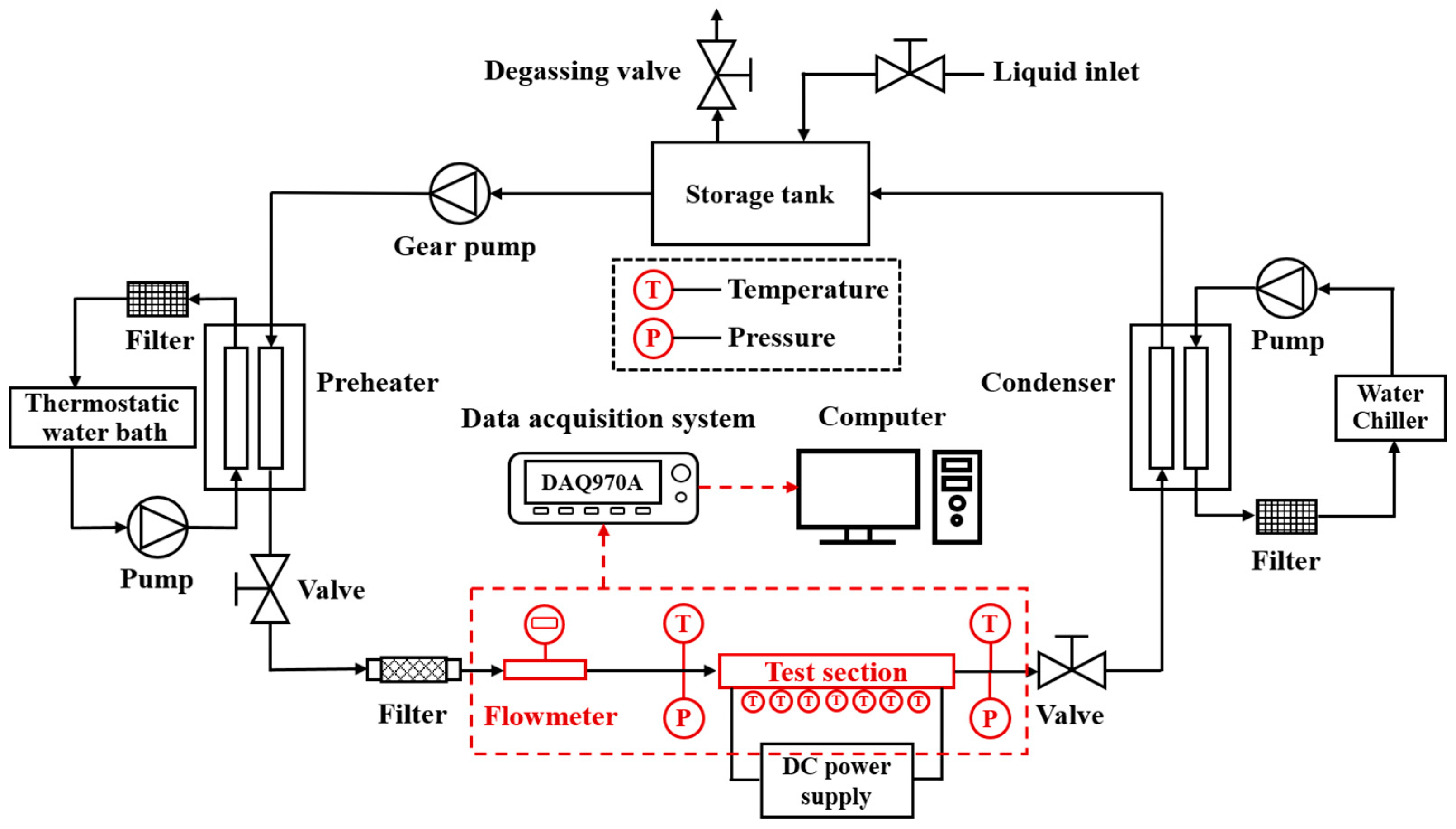


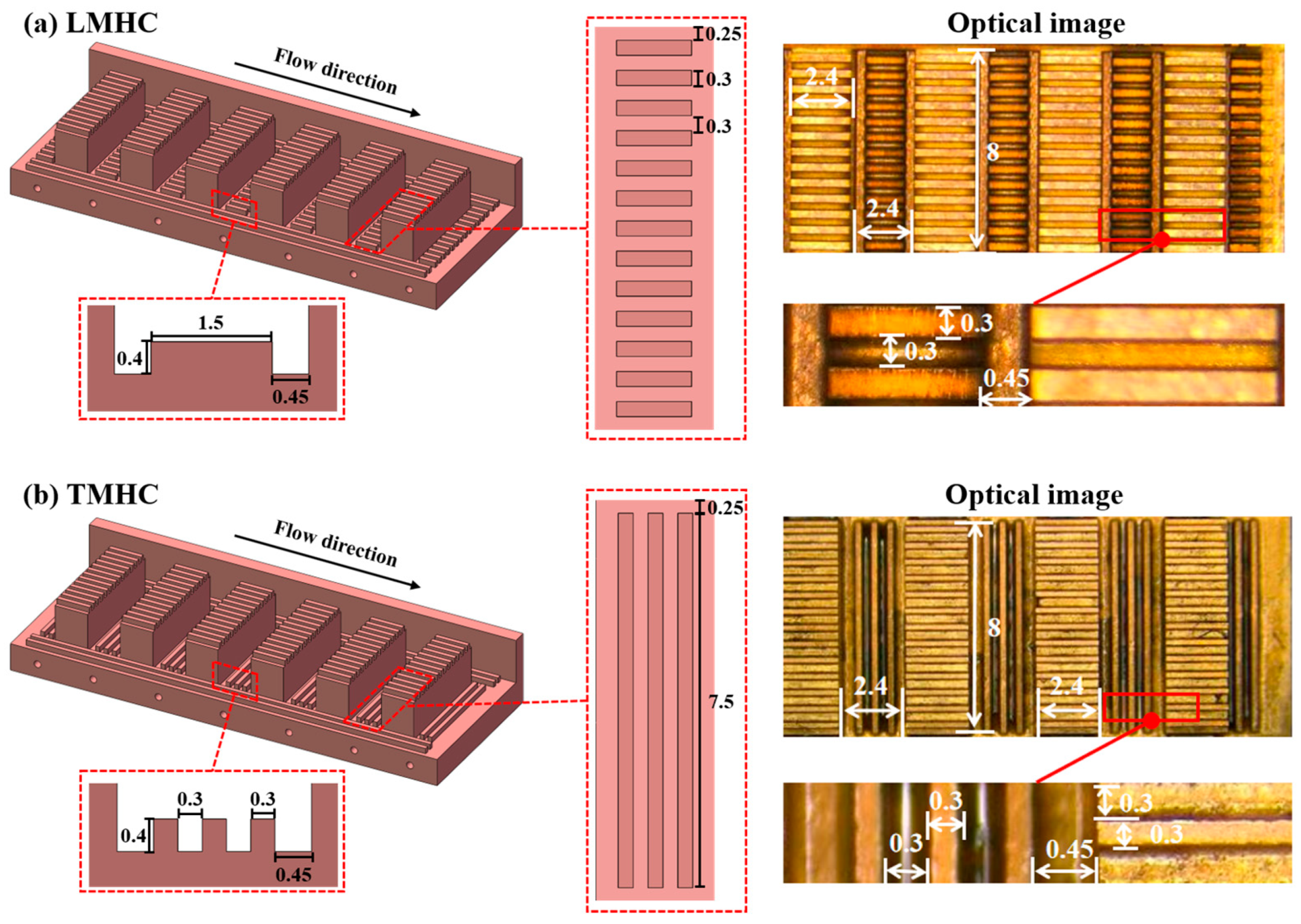



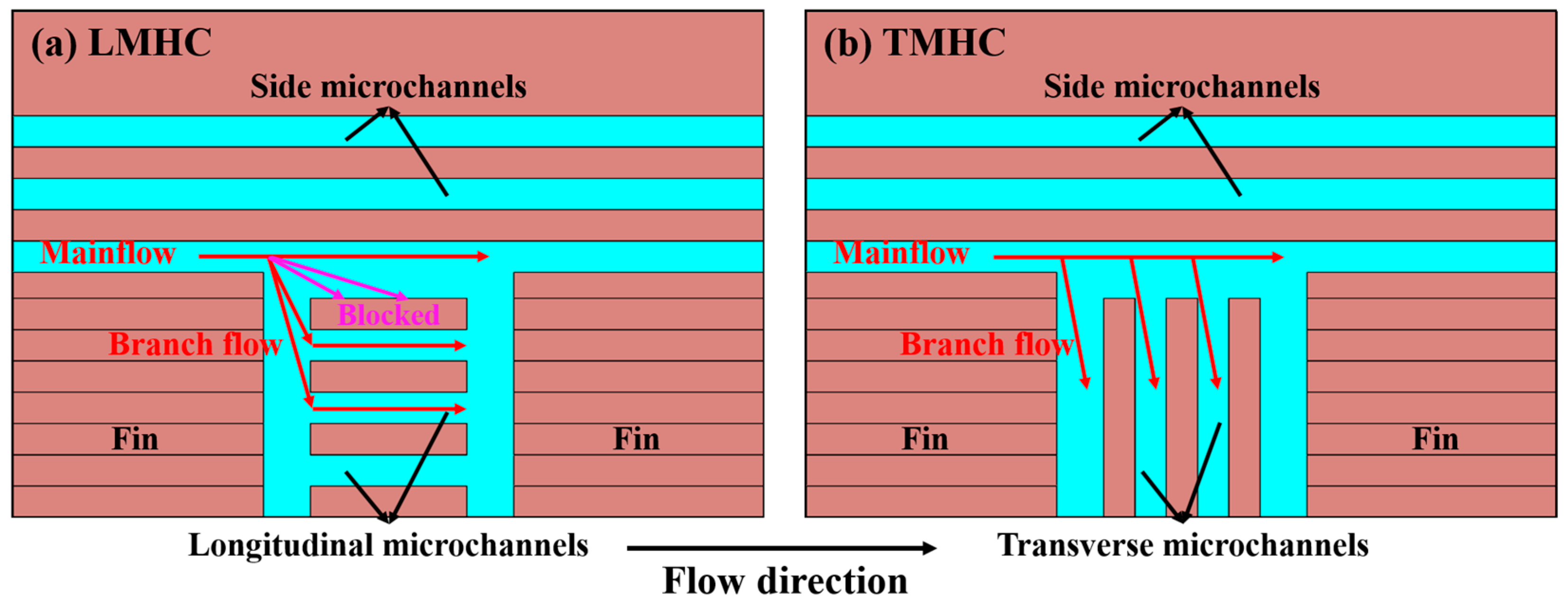

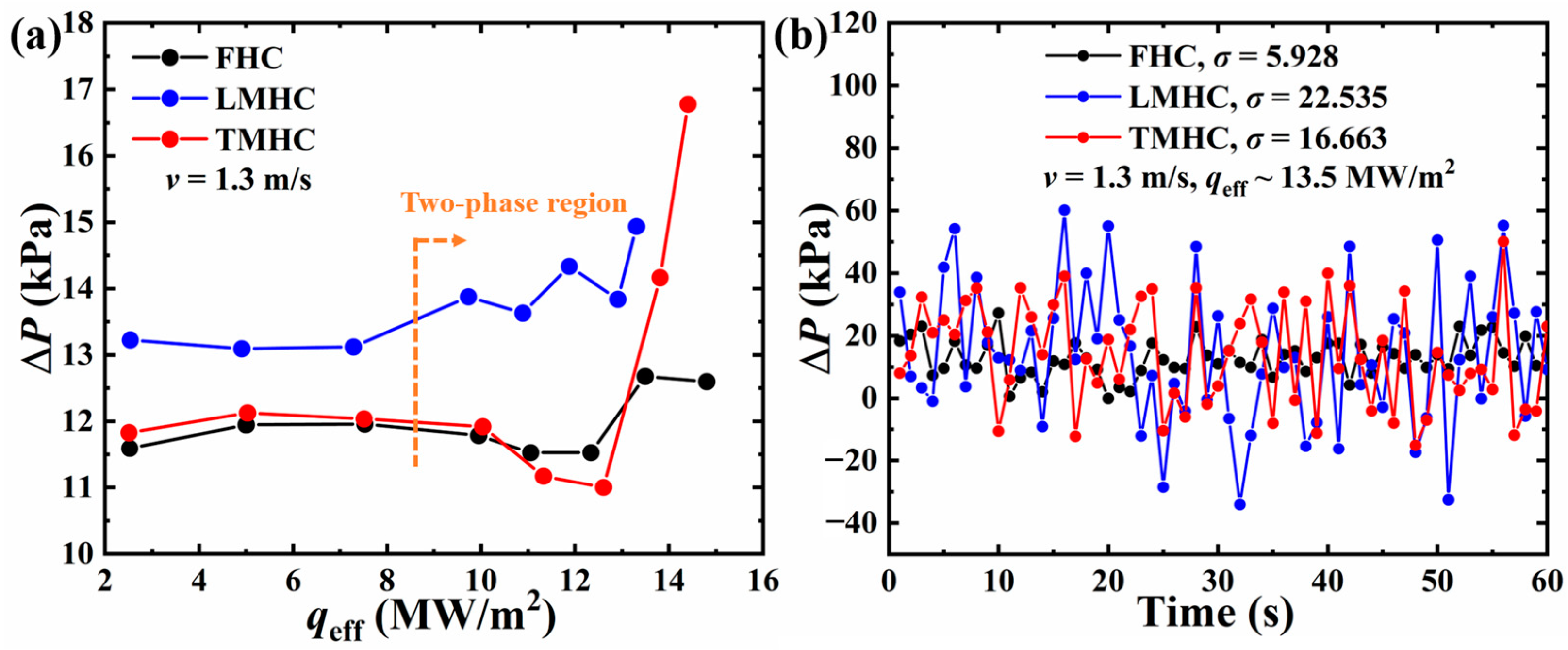
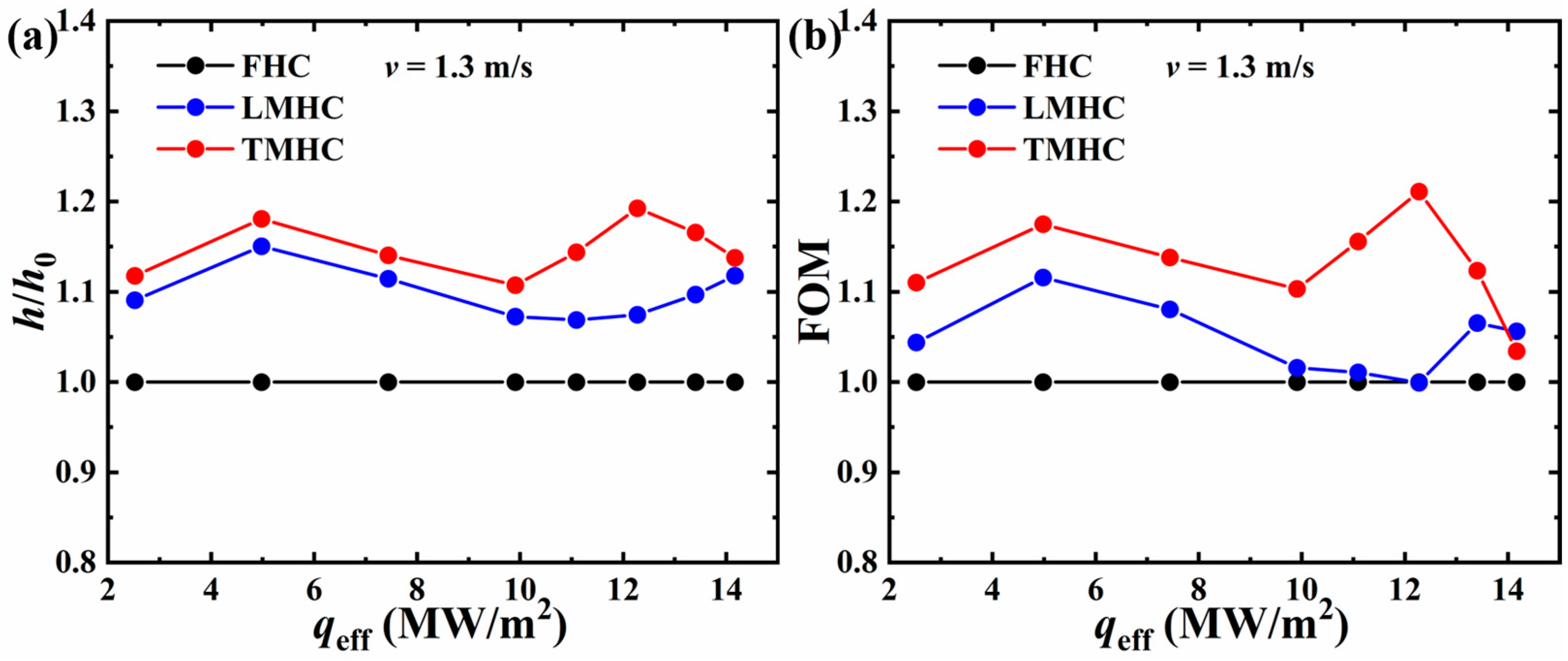
| References | Structures | Materials | Velocities | Major Findings |
|---|---|---|---|---|
| Li et al. [9] | Monoblock | CuCrZr | 4–10 m/s | The structure successfully withstood 1000 cycles at heat loads of 5 MWm2 via an e-beam facility. |
| Chen et al. [10] | Hypervapotron | CuCrZr | 5 m/s | Horizontal and longitudinal ribs were adopted to enhance heat transfer; 9991 cycles with a heat flux of 10 MW/m2 were completed which predicted a fatigue life of 1.2459 years. |
| Zhu et al. [11] | Hypervapotron | Stainless Steel | 2–5 m/s | Heat transfer coefficient was only affected by heat flux in fully developed boiling region; hypervapotron structure could obtain higher CHF values than smooth tubes. |
| Escourbiac et al. [12] | Hypervapotron | Glidcop Al 25 | 4–6 m/s | Heat flux up to 25–30 MW/m2 was able to be removed; surface temperature increased rapidly after 20 MW/m2 which might be the limit for a hypervapotron structure. |
| Youchison et al. [13] | Hypervapotron | CuCrZr | 2 m/s | The width of hypervapotron channels should be less than 50 mm for efficient vapor removal; the CHF reduced with the increase in channel width. |
| Zhao et al. [14] | Hypervapotron | Cu | 0.37–0.756 m/s | Hypervapotron structure could effectively break up and remove the vapor mushroom; CHF was enhanced by 40–60% compared with smooth surface. |
| Wu et al. [15] | Hypervapotron | CuCrZr | 1–2 m/s | Phase change process was independent between each rectangular fin; two symmetrical vortexes in the grooves intensely enhanced liquid–solid convection. |
| Feng et al. [16] | Hypervapotron | CuCrZr | 10 m/s | Continuous V-shaped hypervapotron channels were able to sustain stationary heat flux up to 10 MW/m2 with a flow velocity of 10 m/s. |
| Liu et al. [17] | Hypervapotron | Not mentioned | 5.57~12 m/s | Hypervapotron channel with triangular structures along the flow direction promoted heat transfer as the liquid velocity between the fins was accelerated. |
| Cao et al. [18] | Hypervapotron | CuCrZr | 6–12 m/s | Triangular hypervapotron structures along flow direction could withstand a steady-state heat flux of 10 MW/m2 for up to 7725 heat load cycles. |
| Ezato et al. [19] | Hypervapotron | OFHC–Cu | 2–12 m/s | Hypervapotron channel with saw-toothed fins exhibited 1.3-times higher CHF (43 MW/m2) compared to the rectangular one. |
| Lim et al. [20] | Hypervapotron | CuCrZr | 0.5 m/s | CHF increased with the increase in fin angle of hypervapotron channel in the range of 0–45° and declined when the angle was larger than 45°. |
| Chen et al. [21] | Hypervapotron | CuCrZr | 5 m/s | Hypervapotron channel with cross-ribs showed greater heat transfer capability and obtained only 70% of the pressure drop compared to traditional channel. |
| Chen et al. [22] | Hypervapotron | CuCrZr | 1.6–3.8 m/s | Required heat flux for onset of nucleated boiling for hypervapotron channel with cross-ribs was increased; nucleate boiling was highly activated in two-phase flow. |
| Parameter | Uncertainty |
|---|---|
| Microchannel machining | ±0.01 mm |
| Voltage (U) | ±1% |
| Current (I) | ±1% |
| Liquid velocity (v) | ±2.7% |
| Measured temperature (T) | ±1.5 °C |
| Measured pressure (P) | ±0.3 kPa |
| Heat transfer ratio (r) | ±4.7% |
| Effective heat flux (qeff) | ±4.9% |
| Wall temperature (Tw,i) | ±5.5% |
| Heat transfer coefficient (h) | ±8.1% |
| Pressure drop (∆P) | ±7.7% |
Disclaimer/Publisher’s Note: The statements, opinions and data contained in all publications are solely those of the individual author(s) and contributor(s) and not of MDPI and/or the editor(s). MDPI and/or the editor(s) disclaim responsibility for any injury to people or property resulting from any ideas, methods, instructions or products referred to in the content. |
© 2024 by the authors. Licensee MDPI, Basel, Switzerland. This article is an open access article distributed under the terms and conditions of the Creative Commons Attribution (CC BY) license (https://creativecommons.org/licenses/by/4.0/).
Share and Cite
Meng, X.; Cheng, K.; Zhao, Q.; Chen, X. Hierarchical Hypervapotron Structure Integrated with Microchannels for Advancement of Thermohydraulic Performance. Symmetry 2024, 16, 1089. https://doi.org/10.3390/sym16081089
Meng X, Cheng K, Zhao Q, Chen X. Hierarchical Hypervapotron Structure Integrated with Microchannels for Advancement of Thermohydraulic Performance. Symmetry. 2024; 16(8):1089. https://doi.org/10.3390/sym16081089
Chicago/Turabian StyleMeng, Xin, Kai Cheng, Qi Zhao, and Xuemei Chen. 2024. "Hierarchical Hypervapotron Structure Integrated with Microchannels for Advancement of Thermohydraulic Performance" Symmetry 16, no. 8: 1089. https://doi.org/10.3390/sym16081089




